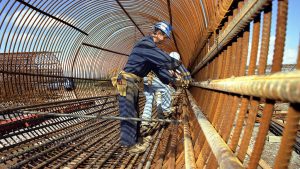A federal review panel has determined that BC Hydro’s Environmental Impact Statement (EIS) for the construction of the Site C dam is good enough for the project to enter the public hearing phase of the assessment process.
“We are obviously very supportive of the Site C dam going forward and are planning to attend the public hearings to make a submission,” said Keith Sashaw, president and CEO of the Association of Consulting Engineering Companies British Columbia.
“It is obvious that the province needs the Site C project to meet the demands of a growing population, as well as the mining, forestry, and oil and gas industries.”
Harry Swain, chair of the federal Joint Review Panel (JRP) sent a letter to BC Hydro on Nov. 7 that said the impact statement for the $7.9 billion Site C dam project will work.
“The panel has determined that the amended EIS, supplemented by the additional information provided by BC Hydro, contains sufficient information to proceed to the public hearing phase of the review,” said Swain.
“The panel recognizes that differences of views still remain between BC Hydro and other interested parties on a number of issues related to the environmental assessment of the project and anticipates that the information generated as part of the amended EIS review will be further developed and clarified through the hearing process.”
The panel is holding the opening session of the public hearings on Dec. 9, 2013 in Fort St. John with other sessions in Fort St. John, Hudson’s Hope, Prince George, Chetwynd, Dawson Creek and Peace River.
The proposed project consists of the construction and operation of a dam and hydroelectric generating station on the Peace River in northeastern BC.
The project would be the third in a series of dams on this section of the river.
The main components of the project are an earth-fill dam 1,050 metres long and 60 metres high, an up to 1,100-megawatt generating station and associated structures, an 83-kilometre long reservoir, re-alignment of four sections of Highway 29 and two 77-kilometre transmission lines along existing transmission line right-of-way connecting Site C to Peace Canyon.
The Site C Dam is being proposed as part of BC Hydro’s overall program to invest in and renew the province’s electricity system.
Electricity demand in B.C. is expected to grow over the next 20 years, driven by a projected population increase of more than one million residents and economic expansion, particularly in the mining and gas industries.
For this reason, the BC government extended the submission due date for BC Hydro’s 20-year plan from Dec. 3, 2012 to Aug. 3, 2013.
By extending the submission date of the Integrated Resource Plan, government, Liquefied Natural Gas proponents and BC Hydro were given more time to complete electricity supply agreements.
“The energy used by LNG is considerable and Site C will not be able to supply all the energy that is needed for all the LNG projects that are currently being put forward,” said Sashaw.
“These projects will generate their own electricity. But, that being said there are a lot of ancillary facilities that will require electricity.”
LNG production and transportation is an energy intensive industrial processes because the cooling process requires enormous amounts of power.
For example, the proposed LNG Gas Canada facility (Shell) in Kitimat will require about 1,200 megawatts of power, compared to the 900 megawatts that will be produced by the proposed Site C hydro project.
This means the province’s future electricity demand will be met by the Site C dam as well as other sources of power, including wind energy and run of river projects.
BC Hydro estimates Site C will generate about 10,000 person-years of direct employment during the construction period.
The estimated average annual construction phase workforce on-site would be about 800 workers, with a peak of 1,700 to 2,100 workers in year five of construction.
Temporary camp accommodations and facilities for the construction phase are planned for the dam site, on both the north and south banks of the Peace River in close proximity to the work sites. The public hearing phase of the environmental assessment is scheduled for completion in January 2014.
Joint Review Panel requested additional information for the public hearings
BC Hydro submitted an amended Environmental Impact Statement (EIS) to the Canadian Environmental Assessment Agency and the B.C. Environmental Assessment Office in August, which marked the end of the pre-panel stage and the beginning of the Joint Review Panel (JRP) stage of the environmental assessment process.
Despite the fact that the information in the EIS is sufficient, the JRP has asked BC Hydro to provide additional information on the effect of price increases on the demand for electricity, Aboriginal harvesting areas, as well as wild life habitat and endangered species.
These are required to help facilitate discussion and should be received by Nov. 20 in advance of the public hearings.
The primary purpose of the hearing is for the panel to receive the required information to complete its environmental assessment of the project.
The hearings give BC Hydro, the public, Aboriginal groups and governments an opportunity to present their views on the project in person to the JRP and discuss its potential environmental, economic, social, heritage and health effects.











Recent Comments
comments for this post are closed